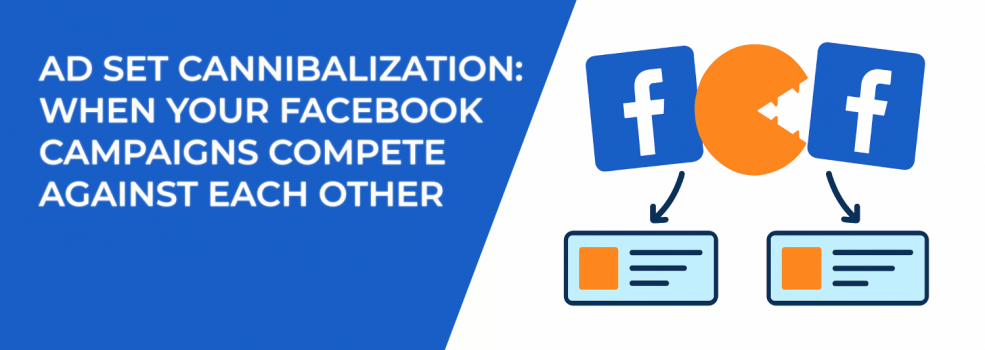Running Facebook ads should feel like building momentum. You test new audiences, experiment with different creatives, and push campaigns to scale.
But sometimes, instead of gaining traction, your campaigns start battling each other for the same eyeballs. That’s ad set cannibalization — when your own ad sets compete for the same people and drive up costs instead of results.
It’s a silent budget killer. Many advertisers don’t realize it’s happening until their numbers start looking strange. If your cost per result keeps rising or your conversions suddenly drop, cannibalization might be the hidden reason.
What Is Ad Set Cannibalization?
Ad set cannibalization happens when multiple ad sets target overlapping groups of people. On paper, the audiences may look different. In practice, they often include the same users.
Here’s what happens in that situation: Facebook sees two bids from you for one person. The algorithm doesn’t care which ad set wins. It simply picks one and charges you for it. This means you’re paying extra without actually reaching more unique users.
Let’s say you run one ad set for “small business owners” and another for “entrepreneurs.” Those audiences sound distinct, but in reality, many people belong to both categories. Instead of expanding your reach, you’ve doubled up on the same people.
That’s why cannibalization is such a problem — it tricks you into thinking you’re testing something new when all you’re doing is splitting attention. If you need a refresher on how targeting works, check out Facebook Ad Targeting 101.
Why Is It a Problem?
At first, ad set cannibalization doesn’t always look obvious. But once you dig into performance, you’ll notice several issues appearing again and again.
When ad sets compete against each other, you usually face:
-
Higher costs per result because you’re essentially raising your own bids.
-
Weaker delivery since impressions get split instead of building momentum in one ad set.
-
Messy data that makes it hard to identify what’s actually working.
-
Slower learning phase because signals are scattered across too many places.
The hidden danger here is how slowly performance can erode. You may think your ads are suffering from fatigue, when in fact the real culprit is overlap. For more on this dynamic, read The Role of Audience Overlap in Facebook Ads Performance.
How to Spot Cannibalization
The sooner you catch ad set cannibalization, the easier it is to fix. But what should you actually look for?
Some signs are clear, like costs rising even when you haven’t changed targeting. Others are more subtle, such as two ad sets showing almost identical performance spikes or dips at the same time. That usually means they’re serving to the same group of people.
The Audience Overlap tool in Ads Manager is also invaluable here. If it shows 30% or more overlap, there’s a good chance your ad sets are colliding.
Another red flag is when a new ad set doesn’t add extra results but instead steals conversions from an older one. This is a classic symptom of overlap — instead of expanding your audience, you just reshuffled it.
Pro tip: don’t just check overlap once. Audiences evolve. As Meta expands targeting through automation, the amount of overlap between ad sets can shift over time. And if you’ve ever seen “Ad Set May Get Zero” warnings in your dashboard, that’s another sign your targeting is too narrow or overlapping — see this guide for a deeper explanation.
How to Fix It
The good news is that ad set cannibalization isn’t permanent. With a few changes to how you build and manage campaigns, you can protect performance and reduce wasted spend.
Here are some practical steps:
1. Combine Audiences
If you’ve sliced your targeting into very small pieces, consider merging them. Broader audiences give Facebook’s algorithm more freedom to find the best people. Instead of having five tiny ad sets that fight each other, you’ll have one stronger ad set with a healthier budget.
2. Use Exclusions
Whenever you test a new audience, set exclusions for groups already covered in other ad sets. This creates cleaner targeting and makes sure you’re not paying for the same users twice.
3. Organize by Funnel Stage
Rather than duplicating similar audiences, structure campaigns around where people are in the buying journey. Have one campaign for awareness, one for consideration, and one for conversion. That way, your ad sets don’t overlap because they’re designed for different stages.
4. Consolidate Underperformers
If you notice two ad sets are producing nearly identical results, there’s little reason to keep both running. By consolidating them into one, you increase budget efficiency and allow Facebook to optimize more effectively.
5. Use Advantage+ Carefully
Meta’s Advantage+ targeting can help reduce overlap since it automatically seeks out the best opportunities. But automation isn’t magic. Keep a close eye on delivery. If performance drifts, step in and adjust.
6. Watch Frequency
High frequency across multiple ad sets can mean you’re hammering the same audience too often. If people see your ads repeatedly in different ad sets, your campaigns are probably overlapping. Adjust your caps or scale back to avoid burnout.
7. Keep a Targeting Map
One of the simplest yet most effective habits is documenting which audiences you’re already targeting. A simple spreadsheet works. This way, you don’t accidentally duplicate the same group across several ad sets.
Is Some Overlap Okay?
Not all overlap is bad. With larger audiences, small amounts of overlap won’t hurt performance much. Sometimes, it’s nearly impossible to eliminate overlap entirely — and that’s okay.
The real danger is when overlap grows big enough to distort costs and confuse the algorithm. That’s when you need to take action. Ask yourself: is the overlap giving me fresh insights, or is it just wasting money? If it’s the second, the fix is worth making.
Final Thoughts
Ad set cannibalization is one of those issues that doesn’t get talked about enough. It quietly eats into your budget and makes performance harder to measure.
But once you know what to look for, it’s easy to spot and fix. Combine your audiences, set exclusions, organize by funnel stage, and check overlap regularly. Those small steps can prevent your ads from working against each other.
Think of your campaigns like a team. Every ad set should play its part, not fight for the same ball. Clean up your targeting, and you’ll likely see stronger results without spending a dollar more.

